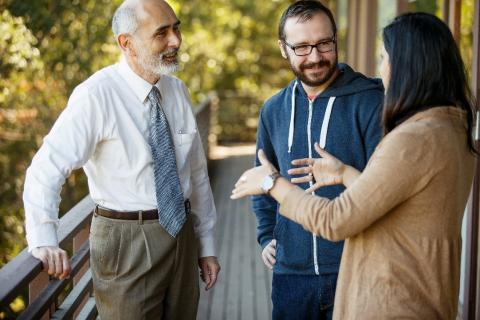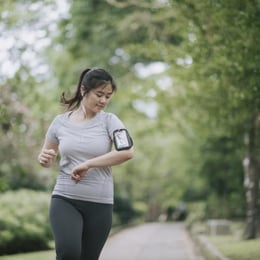
Technology is Key to Improved Mental Health in the Future
Technology and mental health is a growing field, and software engineers are needed to develop effective mobile apps, chatbots, and other digital technologies to improve the well-being of the masses.
“We need to create a partnership between tech and mental health professionals,” said Eduardo Bunge, PhD, professor and associate chair of the Palo Alto University (PAU) Psychology Department. “There are many people working in tech that don’t have a background in mental health, and there are many psychologists creating apps that aren’t engaging or user-friendly. So we need to combine these two skills.”
To train students in both mental health and technology, Bunge developed the Technology and Mental Health Concentration in PAU’s Master’s in Psychology program. “We have many students from the tech industry enrolled in the tech and mental health concentration,” said Bunge.
“They’ve switched careers because they want to help people and feel more purpose in their jobs."
Going into this field, they are using skills they have but for the greater purpose of improving mental health on a massive scale.”
Technological Innovations in Behavioral Healthcare
Current trends in mental health and wellness incorporate technology at many levels. Therapists and counselors can utilize various types of digital therapeutics—such as mobile apps, virtual reality, telehealth, wearable devices, and artificial intelligence—to augment their work and improve outcomes.
Mobile Applications (Apps)
With more and more people around the world gaining access to the Internet and cell phones, mental health apps, such as Headspace and Calm, offer wellness guidance without the cost of therapy. In the PAU Technology and Mental Health concentration, students learn to evaluate mobile apps and have the option to develop their own.
“By developing, evaluating, and using these increasingly prevalent technologies to administer interventions, and providing them in many languages, the potential for reaching underserved populations globally is now an attainable mental health goal,” said Ricardo Muñoz, PhD, PAU Professor Emeritus, and founder of the Institute for International Internet Interventions for Health (i4Health).
Virtual Reality
Many mental health professionals are using virtual reality with their clients to help them overcome emotional obstacles. For example, clients with a fear of public speaking can practice a speech wearing virtual reality goggles that simulate a small audience. Then, after enough practice, they may be ready to simulate talking to a medium and then a large audience.
“Virtual reality offers the intermediate steps for people to overcome their fears,” says Bunge.

Ricardo F. Muñoz, PhD on PAU Campus
Telehealth
Telehealth allows the practitioner to offer health care through an online platform, such as live video, audio, or instant message. The pandemic expedited telehealth to become the standard of practice, and now that the pandemic is over, many people would rather stay home and continue their therapy virtually.
“Telehealth offered by therapists and counselors, or telemental health, is revolutionary for clients who don’t want to be seen in a waiting room,” said Donna Sheperis, PhD, professor and associate chair of the PAU Counseling Department, and Director of the PAU eClinic. “With telemental health, I see more high-profile clients like celebrities; I have more trans clients; I see more busy professionals who can’t take two hours to drive across town and sit in a session. It’s more convenient, and we are seeing that it is equally as effective.”
Wearable Devices
There are many human behaviors that therapists and counselors are not able to track without technology. Wearable devices can monitor data in between sessions and help practitioners get a bigger picture of what is going on with their patients. For example, a sleep monitor worn on a client’s wrist every night can provide more accurate data than the client answering the question “How have you been sleeping?” during a weekly session. This precise data allows practitioners to improve their assessment of what is happening with their patients day in and day out and therefore tailor their treatment accordingly.
“We can’t solve all the mental health problems in the world just by talking an hour a week with our clients,” said Bunge. “We currently ask patients how they are feeling, but with devices that they wear all the time, we can get more subjective data about their nervous system that is not self-reported.”

June 1, 2023 - Practitioner of Distinction Honors Awarded to PAU’s Donna Sheperis, PhD
Artificial Intelligence, such as ChatGPT and Chatbots
Bunge sees the rapid growth of ChatGPT, chatbots, and other forms of artificial intelligence (AI) as a huge opportunity to make significant improvements in mental health technology. At PAU, Bunge uses ChatGPT to expedite his research and teaches his students how to utilize the technology effectively in their research.
Chatbots, computer programs designed to simulate conversations with human users online, are another form of AI being developed to offer mental health assistance. This digital therapy is especially helpful when patients need support during non-working hours. For example, a chatbot can provide a therapy session at 2 a.m. when the client needs it most, and the therapist is not available.
Some therapists and counselors are afraid that AI will take their jobs, but Bunge doesn’t think that will happen. “AI is an infinite resource for us, but humans are needed to discern which information is most relevant,” he said. “We can think of AI the way we think about medication. If you go to a pharmacy and have access to every type of medication, that won’t solve your mental health problems. Just like you need the pharmacist to discern which medication to take and how often, we need mental health professionals to help clients use AI effectively.”
How PAU is Training Students in Technology and Mental Health
The PAU Technology and Mental Health concentration is part of the University’s Master’s in Psychology program. It is ideal for those in technology who are seeking a career change into mental health. The program trains students to recognize the crucial role technology plays in today’s society and the complex interaction between technology and human behavior. Students take the psychology courses to complete PAU’s Master’s in Psychology degree as well as concentration-specific courses on the impact of technology on child and adolescent development, the efficacy of online psychological interventions for health, the Cognitive Theory of Multimedia Learning, and mental health and design in the digital world.

“What we teach..
.. in the concentration is how to identify effective, research-based digital interventions that enhance mental health for children, adolescents, and adults, and how to create an effective tech product themselves,” said Bunge.
During the program, students develop their own mental health digital intervention—such as a mobile application or wearable device—that is user-friendly and engaging for a specific audience. Since PAU is located in Silicon Valley, many students pitch their digital therapeutic to local investors.
Graduates of this program work in technology and mental health startups, NGOs, government agencies, user-experience (UX) research, and education. Many alumni play important roles within digital mental health companies and organizations that incorporate technology into clinical care.
Key courses in PAU’s Technology and Mental Health Concentration:
- Technology and Mental Health for Children and Adolescents
- Evidence-based Digital Interventions to Reduce Health Disparities
- Principles of Multimedia Learning for Product Design
- Mental Health and UX Design in the Digital World
Final Project: Students create an original technological product that is related to mental health.
With the mental health crisis continuing to rise, Bunge believes that the application of technology is the next level of improvement regarding mental health treatment. “We’ve tried to solve human problems with one-on-one talk therapy, but that was not enough. Then, medication came on the scene, and it was still not enough,” he said. “Technology is a third resource to support people in their wellness, but we need great tech minds to help mental health professionals create effective digital interventions.”




-1200x628.jpg?width=352&name=Blog-What%20You%20Can%20Do%20With%20An%20MS%20In%20Psychology_%20The%20Pathway%20To%20Possibility%20(2)-1200x628.jpg)